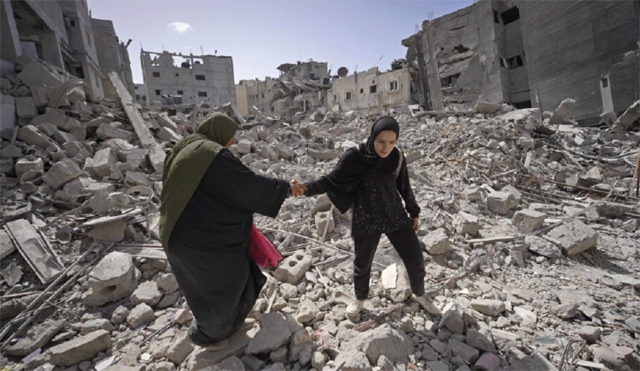You are here
‘Cry in a Long Night’, an allegory of Jerusalem, says scholar
By Saeb Rawashdeh - Jul 16,2022 - Last updated at Jul 17,2022

Jabra Ibrahim Jabra
According to an American scholar, who received his PhD from Harvard,where he studied comparative literature and Arabic, the main motif of “Cry in a Long Night” is redemption, both individual and collective.
“It’s an appropriate theme for a novel set in the Holy Land during anational crisis. How would Amin, the protagonist, be saved? How would his compatriots be saved? Those are the questions at the heart of the book,” noted William Tamplin, adding that the book’s ending hints at an answer.
“I find the answer given by the Syrian critic Faysal Darraj to be the most convincing: Jabra Ibrahim Jabra [a Palestinian-Iraqi writer born in 1919 and died in 1994] thought Arabs needed to save themselves individuallybefore the Arab nation could be saved collectively. Jabra believed every Arab would have to adopt the responsibility of redemption on his or her own; no political party or movement would save them,” Tamplin underlined.
How would the Arabs redeem themselves? For Jabra, they would have to overcome the suffocating customs and traditions that had hindered them from entering modernity, Tamplin said, adding that it would require individual actions on a mass scale.
Jabra was a politically cautious man: “Although Jabra was a Palestinian patriot, I don’t think he was affiliated with any particular political factions, as former Palestinian culture minister Yasser Abed Rabbo points out in a recent Al Jazeera documentary. And Jabra was wary of the fickleness of crowds – his novels abound with scenes of crowds run rampant, crowds bent on destruction for its own sake.
Murderous crowds lynched his mother’s first husband, and mass political violence was a fixture of life in Palestine beginning in 1929, when Jabra was a boy. Jabra was suspicious of the mob. Yet, he believed in the individual and in his or her capacity to be transformed, to be redeemed,” Tamplin underlined.
Furthermore, the city portrayed in “Cry in a Long Night” is an allegorical city, the scholar said.
“It’s never given a name, just ‘The City’.Yet, the city resembles Jerusalem in the mid-1940s. Jabra signs the last page of the novel ‘Jerusalem, summer 1946’ as if to assign his allegorical city a place and a time.
If you read the history of Jerusalem in 1946, many events that occurred thereecho in ‘Cry in a Long Night’. In July 1946 the Irgun blew up the King David Hotel in a double explosion; a double explosion also graces the final chapters of Jabra’s novel,” Tamplin stressed, adding that in the novel, policemen guarddifferent sectors of the city, and in 1946, Jerusalem was divided into three sectors, each one separated by checkpoints.
“Finally, there’s the juxtaposition of extreme poverty and extreme wealth in the novel, as in 1940s Palestine,”Tamplin said.
Jabra’s Jerusalem is depicted as a place full of aimless, wandering souls unsure about their political and personal futures, he elaborated, adding that Palestinians in the mid-1940s, as depicted by Jabra, were in their labyrinth, their dark night of the soul.
“Their political leadership is feckless and drunk on its bygone glory, the bourgeoisie is politically indifferent, and the general population cares mostly about putting food on the table.
By the end of the book, Amin has achieved a release from his own individual suffering. And he wishes the same for all his compatriots. But he recognises that he cannot free them; they must free themselves by voluntarily confronting their challenges both personal and political,” Tamplin underlined.
Jabra was extremely prolific, and Al Jazeera recently released a documentary on him titled “Nahrunduna difaf”, or “River without banks”.
“That captures it: if Jabra was a river, he overflowed his banks with creativity. He wrote six or seven novels, a collection of short stories, several diwans of poetry, a study of modern art in Iraq in the 1950s, and much literary and cultural criticism.
He painted. And from French and English, languages he knew extremely well, he translated into Arabic everything from modern American short stories to ‘Waiting for Godot’ to Shakespeare’s ‘Twelfth Night’ to scholarship on ancient Mesopotamian philosophy to a biography of William Faulkner.
Iraqi scholar Majed Al Samarra’i claims that Jabra produced sixty-four books in his seventy-five years. That’s a testament to how prolific Jabra was. Finally, Jabra served as a dedicated mentor to a generation of Arab writers and thinkers, who encouraged his students’ creativity, convened artistic and literary salons, and penned introductions to his friends’ work,” highlighted Tamplin.
Arab Apocalyptic novel
“The apocalyptic Arabic novel was the subject of my doctoral dissertation. I was interested in applying the popular, or sha‘bi, worldview of “apocalypticism” to the Arabic novel,” Tamplin said, adding that he would spend time in the Arab world and encounter dozens of people who spoke passionately about how near the end times were.
At the same time, Tamplin found it strange that so little had been written on this phenomenon in scholarship on the contemporary Arabo-Islamic world.
“When I was a graduate student, it was a taboo to point out anything potentially embarrassing about Arabs or Muslims without taking pains to point the finger, in the final analysis, at the devious West, the putative source of all the East’s problems. In short, there was a huge gap between what I observed on the Arab street and what I heard in the ivory tower,” he pointed out.
Tamplin’s decision to focus on apocalypticism was in part a response to the concerns of his fellow academics.
“In my experience, scholars of Arabic and Middle Eastern literatures were content to apply trendy critical theory to third world literatures. And that’s fine. But in my dissertation, I wanted to use a method of analysis provided by the cultural context also responsible for producing the literature I was studying.
So I chose apocalypticism,” Tamplin elaborated, noting that he went in search of Arabic novels that used apocalyptic imagery.
“I ended up focusing on Jabra’s ‘Cry in a Long Night’, three novels by Naguib Mahfouz written in his existential period, ‘The Earthquake’ by Tahar Ouettar, and Ahmed Khaled Towfik’s ‘Utopia’,” Tamplin said, adding that he ended up realising that, with the exception of Ouettar’s “The Earthquake”, these novels did not draw on the extremely rich apocalyptic tradition in Islam.
“On the contrary, all of them, including ‘The Earthquake’, adapted masterpieces of Western literature. So my dissertation, which began as a study of apocalypticism, became a study of influence and adaptation,” Tamplin highlighted.
“I asked myself why these Arab authors chose to adapt the specific Western masterpieces that they did. I believe they sought to compare the desperation of their particular social and political moments to ones already well depicted in Western literature. ‘Utopia’s’ wasteland of Egypt in the 2020s is largely based on H.G. Wells’ ‘The Time Machine’ and Zola’s ‘Germinal’, both of which were responding to the living hell of factories and mines in late nineteenth-century Europe,” Tamplin said.
The “Earthquake” can be read as an Algerian adaptation of Sartre’s novel “Nausea”, and the same goes for Jabra’s novel “Cry in a Long Night” and T.S. Eliot’s “The Waste Land”, he said, adding that Jabra was fond of pointing out that the trauma of World War I was to Europe as the trauma of 1948 was to the Arab world; that’s why so many Arab poets of the 1950s were obsessed with Eliot’s World War I epic.
“As with the taboo I mentioned earlier, it can be touchy to point out the extent to which Arabs have borrowed ideas from Western science, literature, art, and thought given the recent history of Western colonialism and the pride many Arabs take in their civilisation’s achievements.Yet I would venture to claim that Arab authors don’t have the hang-ups that contemporary Western academics do about cultural appropriation and adaptation. Like artists in every time and place, Arab writers are just as content to steal, adopt, adapt, conceal and remold the work of the giants whose shoulders they stand on,” Tamplin underscored.
Related Articles
PARIS — Hundreds of migrants pitched tents in central Paris on Tuesday to call attention to their plight on the streets, where they scrape b
GAZA STRIP, Palestinian Territories — Shell-shocked Palestinians who returned Thursday to part of Khan Yunis where Israeli soldiers have car
AMMAN — Bedouin poetry represents one field of intellectual interest for an American scholar specialising in comparative literature and Arab


















